Chapter 1 Antibodies
1/73
Earn XP
Description and Tags
Dako IHC Staining Methods 5th Edition
Name | Mastery | Learn | Test | Matching | Spaced |
|---|
No study sessions yet.
74 Terms
Antibodies belong to a group of proteins called what?
Immunoglobulins (Ig)
5 major classes of immunoglobulins?
IgG, IgA, IgM, IgE, IgD
Antibodies (Immunoglobulins) are made up of what components?
They are made up of 2 identical heavy and 2 identical light chains, connected by disulfide bonds.
The class and subclass of immunoglobulins is determined by what?
The Heavy chain
What are the subclasses of Light chains on immunoglobulins?
The subclasses of light chains on immunoglobulins are kappa and lambda.
Which classes of immunoglobulins are the most frequently utilized?
IgG and IgM
What contributes to the structure and stability of immunoglobulins?
Interchain and intrachain disulfide bonds.
The heavy chains of the IgG immunoglobulin are called?
Gamma chains
What is the general formula of IgG?
γ2κ2 or γ2λ2
IgG is divided into what 2 domains?
Variable and constant domains
Each of the IgG domains contains?
110-120 amino acids and 1 intrachain disulfide bond.
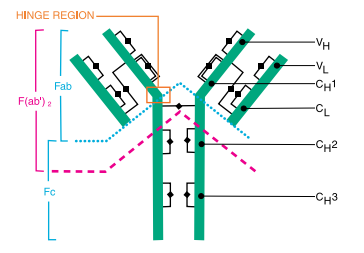
What Variable and constant domains exist in IgG?
Light chain: VL and CL, Heavy Chain: VH1, CH1, CH2, CH3

Where are the amino terminals of the immunoglobulin located?
1 on the Variable domain of the light chain and 1 on the Variable domain of the Heavy Chain
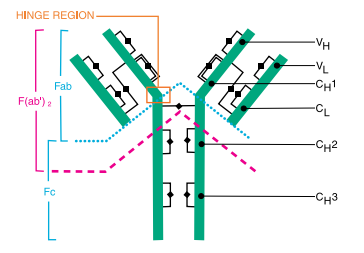
Together the Variable domains of the light and heavy chain form what?
The “antigen-combining site” also called the antigen-binding site of the antibody
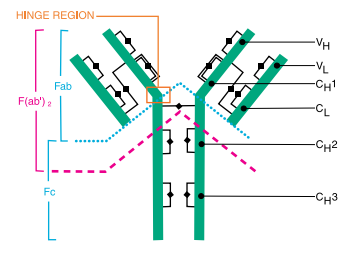
What are Idiotypic Determinants?
Unique antigen-binding sites on antibodies that define specificity. They are located in the hypervariable region of the Variable domains. Each antibody clone expresses its own idiotype.
Which chain carries the carboxyl terminal portion of the IgG immunoglobulin?
Heavy Chain
Where are the hinge regions of the IgG located?
Between the CH1 and CH2 domains of the heavy chains, allowing flexibility.
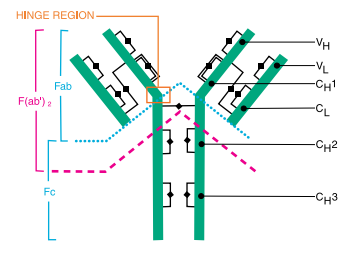
What contributes to the IgG subclass specificity?
Minor differences in the Hinge Regions
What are the common ratios of IgG Kappa to Lambda Light chains?
Human IgG typically has a ratio of 2:1 for Kappa to Lambda light chains.
Subclass IgG2 is 1:1
Subclass IgG4 is 8:1
Mice have approximately 95% Kappa chains, so most IgG antibodies from this species have K Chains.
What things vary between the IgG Subclasses?
The structure of the hinge region
Flexibility of the hinge region to allow for varying distances between identical antigens
The number of interchain (linking the heavy chains) disulfide bonds
The ratio of Kappa to Lambda Chains
Enzymatic digestion of the IgG by papain results in what?
Results in cleavage of the susceptible bond on the N-Terminus side of the inter-heavy chain disulfide bridges, producing of two Fab fragments and one Fc fragment.
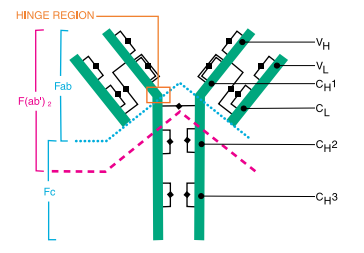
Enzymatic digestion of the IgG by Pepsin results in what?
Pepsin cleaves the gamma chains on the C-Terminus side of the inter-heavy chain disulfide bridges, resulting in the production of a F(ab')2 (2 connected subunits of Fab) fragment and the Fc fragments are destroyed.
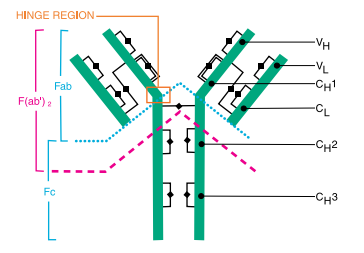
How does Reductive Dissociation affect the IgG Immunoglobulin?
Reductive dissociation breaks the interchain disulfide bonds, separating the IgG into its individual 2 heavy and 2 light chains.
IgM has what kind of structure?
A pentamer structure consisting of five monomer subunits joined by a J chain (sulfhydryl-rich peptide), providing high avidity for antigens.

What is the general formula for IgM?

What is the function of the J chain in an IgM immunoglobulin?
The contribute to the integrity and stability of the pentamer structure.
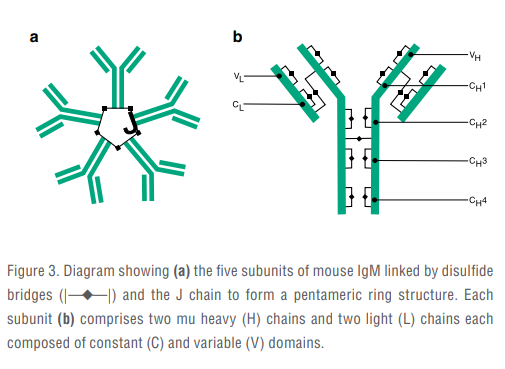
Treatment of IGM pentamer with 0.1% mercaptoethanol results in what?
it cleaves the disulfide bridges between the subunits to yield 5 monomers.
___is the most abundant antibody in the hyperimmunized host, and ___ is the first humoral antibody detectable in the newly immunized animal.
IgG, IgM
What are the stages of primary antibody formation?
The injected antigen (immunogen) first reaches equilibrium between the extra- and intravascular spaces.
Then is undergoes catabolism resulting in smaller fragments
Finally it is eliminated from the intravascular spaces by the newly formed antibodies.
What is the time frame for the stages of antibody formation and half-life?
The period from the injection of an antigen until the first appearance of humoral IgM antibodies is called the latent period and may last approx. 1 week.
Within 2 weeks, or in response to a second injection IgG class antibodies usually predominate.
IgM antibodies have a half-life of 4-6 days
IgG Antibodies have a half-life of approx. 3 weeks
Another word for antigen?
Immunogen
Polyclonal Antibody
Are a heterogenous mixture of antibodies directed against various epitopes of the same antigen.
How are polyclonal antibodies produced?
They are produced from different B-cell clones of the animal and as a consequence are immunochemically dissimilar. The antibodies in a polyclonal mixture can have slightly different specificities and affinities for the target antigen.
Polyclonal Antibodies are most frequently taken from what animal and why?
They are most frequently taken from rabbits due to their robust immune response and ability to produce a diverse range of antibodies.
What is the purpose of combining an immunogen with an adjunct before administering to the target animal?
To enhance the immune response by increasing the effectiveness of the immunogen and promoting a stronger antibody production.
What is the purpose of combining immunogens with carrier proteins?
For smaller less immunogenic proteins or peptides it is to improve immunogenicity and enhance the immune response by providing a more recognizable target for the immune system.
Examples of carrier proteins: Keyhole limpet hemocyanin (KLH), Bovine Serum albumin (BSA), Ovalbumin (OVA), and Purified Protein Derivative of Tuberculin (PPD)
How is the blood transformed into polyclonal antibody?
The blood is transformed by isolating serum (centrifugation) containing a mixture of antibodies that are produced in response to various antigens, resulting in a polyclonal antibody preparation.
The serum is then purified to obtain the antibodies. The purification can occur through ammonium sulfate precipitation and ion exchange chromatography, Protein A or G purification or affinity isolation.
What are monoclonal antibodies?
A homogenous population of identical antibodies produced by a single clone of B cells, targeting a single antigen.
Where are animals immunized with antigen for monoclonal antibodies?
Intraperitoneal space
How are the monoclonal antibodies harvested from the target animal?
The animal is sacrificed and the B cells are isolated from the spleen. The B cells are then fused with an immortal cell line (Myeloma) to create a hybridoma or immortal antibody producing cell.
How are antibodies harvested from the hybridoma?
The hybridoma cell line is cultured, selected and sub-cultured to isolate a stable clone with high antibody production capacity. This chosen clone is then cultured on a mass scale. The antibodies can be purified using protein A or G chromatography or affinity purification.
Why might rabbits be better for monoclonal antibody production, and why aren’t they used frequently?
Rabbits produce a larger variety of antibodies due to their unique immune system, but the rabbit hybridomas do not produce as well as mice hybridomas.
Intrinsic affinity of an antibody resides where?
In the Hypervariable region
Intrinsic affinity of an antibody is determined by what?
In the Hypervariable Region it is determined by the same sequence of amino acids that determines specificity.
What are the paratope and epitope?
The paratope of the antibody is the Antigen binding site, that binds to the epitope of the antigen.
What forces contribute to the binding of an antibody to the epitope?
Primarily ionic (electrostatic), but also hydrogen bonding and van der Waals forces. Hydrophobicity forms last and has a stabilizing effect on the formed immune complex, and with soluble reactants usually leads to its precipitation.
Covalent Bonding between the antibody and antigen DOES NOT OCCUR.
What is the measure of an antibodies affininty?
The association constant (Ka) of the binding between an antibody and its antigenic determinant is a measure of the antibodies affinity.
It can range from 10³ to 10^10 liters/mole and is the reciprocal of concentration in moles/liter.
How does the intrinsic affinity affect the ability to reach equilibrium?
The higher the intrinsic affinity of the antibody, the lower the concentration of antigen needed for the available binding sites of the antibody to become saturated (reach equilibrium).
How are antibodies affected with increases immunization time?
Just as the quantity (titer) of an antibody increases with time during immunization, so does its quality (affinity). This is also called “affinity maturation”
How do lower doses of immunogen affect the affinity maturation?
Lower doses increase the rate of affinity maturation, but may result in lower titers of antibody and vice versa.
What is the functional affinity of an antibody?
Can be loosely defined by the time required to reach equilibrium with the tissue antigen. An antibody that reaches the plateau of maximum staining intensity quickest is of a higher functional affinity.
What term is synonymous with functional affinity?
Avidity-
but this term has also been used to denote the strength of the binding reached between the antibody and its antigen.
Also used to describe the sum total of all intrinsic affinities found in polyclonal antibody population.
The affinity of antibodies is relted to their capacity to form what?
Insoluble immune Complexes. Generally, higher affinity of an antibody means a greater tendency for it to precipitate. Though it is rare in Monoclonal Antibodies.
What is precipitation of the Antibody/ antigen binding complex?
Precipitation proceeds through a rapid stage in which soluble antigen-antibody complexes form, followed by slower aggregation and eventually precipitation.
Non-precipitating antibodies are mostly of lower affinity and are incapable of forming the lattice required for precipitation to occur.
What is Prozone
A property in which some antibodies, when insufficiently diluted, fail to agglutinate (stick together) cells even though higher dilutions will do so. While prozone can also be observed in precipitin reactions, in IHC it is a rare event.
Most antibodies carry a net ____ Charge?
A net positive electrostatic charge.
The strength of the Antibodies affinity for the target tissue antigen also depends on the availability and abundance of what?
Of the net negative electrostatic charges in the target tissue, because the antiboies carry a net + charge
What factor affects the net negative electrostatic charge of the target tissue?
Excessive formalin fixation. The charge/affinity can be restored though heat-induced retrieval for all antigens.
Cross-reactivity
Immunochemical activity that can occur between and antibody and 2 or more antigens or vis versa when an antigen reacts with several different antibodies
Cross-reactivity examples
When Anti-L or Anti-K chain antibodies interact with all 5 Ig classes, or when carcinoembryonic antigen (CEA) reacts with antibodies against CEA, Blood group antigens and normal tissue proteins, respectively.
Antibody Cross-reactivity
When an antibody with similar or dissimilar epitopes on unrelated antigens. This is frequently a property of low affinity antibodies and is subject to change because of affinity maturation during immunization.
What factors affect antibody reaction rates?
Length of tissue fixation, antibody concentration, ambient temperature…
What has been done to shorten extensive incubation time for antibodies?
To increase the reaction rate higher concentrations of high-affinity primary and linked antibodies are used. but in these situations equilibrium is rarely achieved- because it requires very long incubation periods with more dilute antibodies.
Why aren’t shorter incubation times with more concentrated antiboies used to reach equilibrium more quickly?
Because nonspecific background staining will result
Does the size and/or shape of the antibody affect staining?
No, generally the size and shape of the antibody molecule are of little consequence to IHC. But gross over fixation of tissue may make penetration more difficult for antibodies overall.
What factors during purification affect the stability of antibodies most?
Exposures of antibodies to to extreme PH, as well as high or very low concentrations of salts during purification tends to decrease their stability more then does exposure to mild conditions, such as ion exchange chromatography.
What changes are seem in Polyclonal antibodies after prolonged storage?
Formation soluble aggregates, and subsequently precipitated polymers. These changes are probably the result of hydrophobic interaction between the IgG molecules in solution.
While the presence of soluble agreggates may enhance their performance as precipitating antibodies, their increases hydrophobicity has been shown to cause increased non specific binding.
also Conjugation with glutaraldehyde.
Conjugation with glutaraldehyde.
After prolonged storage, conjugation with glutaraldehyde involves the epsilon-amino groups of lysine and alpha-amino groups of the N-terminal amino acids resulting in their cross linking.
Because there are many glutaraldehyde-reactive sites on IgG molecules, the hydrophobicity of the conjugated antibodies may increase significantly, resulting in augmented attraction to hydrophobic sites in the fixed tissue and increased background.
What containers are recomended for antibody storage?
Polypropylene, polycarbonate or borosilicate glass are recommended because of their negligible protein adsorptivity.
What precautions should be taken when storing very low concentrations of antibodies < 10-100 ug/ml?
An immunochemically inert protein, such as bovine albumin should be added to reduce loss through polymerization and adsorption onto the container.
What effect with freezing have on most RTU antibodies?
Freezing and thawing of RTU Antibodies is known to have deleterious effects on their performance.
How does hemolysis in the antiserum affect staining?
Hemolysis results from suboptimal bleeding techniques, but most likely will not interfer with IHC staining, though excessive hemolysis should be avoided.
If excessive hemolysis or lipemia is encountered, isolation of the immunoglobulin fraction from the antisera may be necessary. Such isolates will usually appear as colorless and clear.